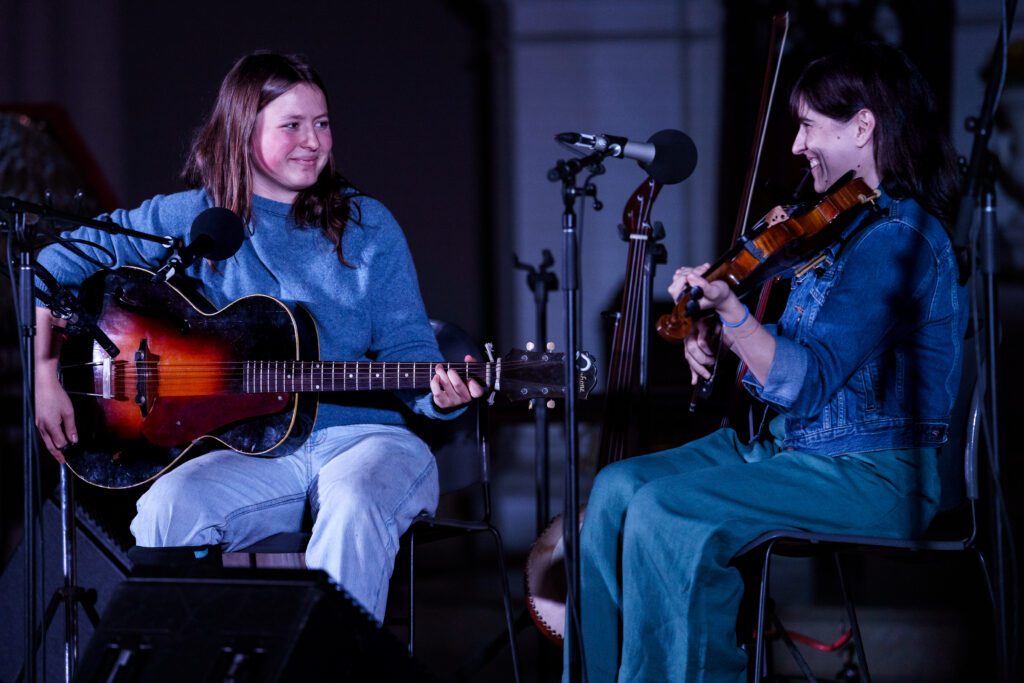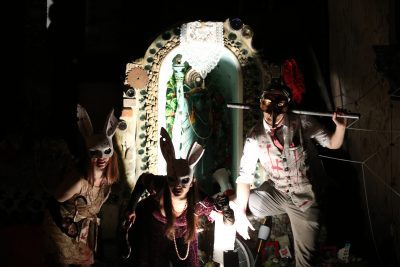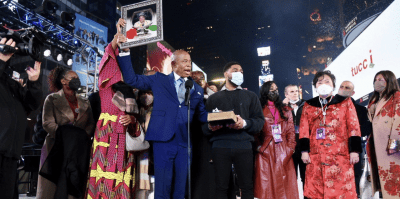Brown on the banjo at Brooklyn Folk Festival (Photo by Brian Geltner)
One of Brooklyn’s brighter folk stars is just 18
Nora Brown has already recorded four albums and a Tiny Desk session on an unlikely instrument for a teen: a banjo
On stage beneath the Gothic-arched stone ceiling of Brooklyn’s Church of St. Ann & the Holy Trinity, Nora Brown plucks the sweet, mellow notes of “Copper Kettle,” a traditional folk song about making moonshine, on her guitar.
“Just lay there by the juniper while the moon is bright/watch them jugs a-filling in the pale moonlight,” she sings, seated and half-facing her frequent collaborator Stephanie Coleman, accompanying her on fiddle.
The audience at the Brooklyn Folk Festival, crammed together into church pews, leaning over the choir loft railing above and clustered cross-legged on the floor in front of the stage, listens with intent.
“It’s something that’s shared with families and friends; it’s not really performing music. So the fact that it was never really meant for a crowd makes it very personal,” Brown says of the old-time music she plays.
At just 18, Brown has recorded three full-length albums and released an EP of duets with Coleman. She’s charted on the Bluegrass Billboard charts, performed at a recent NPR Tiny Desk concert, appeared at Newport Folk Fest, the Lincoln and Kennedy Centers, Hardly Strictly Bluegrass, and toured Denmark, the U.K. and Canada (all while racking up other accolades).
As a teenager, Brown gravitated toward different music than many of her peers, traveling to visit and study with folk music legends including John Cohen and Lee Sexton. Old-time music (a precursor to bluegrass and modern country music) is finger-picked on acoustic stringed instruments – Brown plays banjo and guitar – often accompanied by a fiddle, and devoid of solos or flowery harmonies. Brown learned it just as generations before her had, directly from other musicians, often sitting knee-to-knee with them at folk music gatherings.
“There’s a way that the music becomes a part of you, if you listen to it,” says folksinger Alice Gerrard, half of the groundbreaking bluegrass duo Hazel and Alice formed during the Greenwich Folk Revival. To Gerrard, who produced Brown’s first album, “Cinnamon Tree,” released when Brown was just 13, Brown’s meticulous study of folk traditions through its elders has grounded her in the tradition. “Here’s a young woman who as a child loved this music and wanted — she didn’t go for the purple dinosaur, she went for this real music,” she says.
Coleman first met Brown a half-dozen years ago at a jam session at Sunny’s Bar in Red Hook. When she walked in, she spotted Brown, who was 12 or 13 at the time, in the middle of the circle, playing banjo.
“She had that thing that makes me stop when I hear Roscoe Holcomb [a legendary Kentucky folksinger] sing, that makes me unable to pay attention to anything else in the moment,” Coleman says.
Both Brown and Coleman fell in love with old-time music as young children. As Coleman joked when the duo performed on NPR’s fabled Tiny Desk Concert last month: “We were both middle schoolers obsessed with old banjo players.” Although Coleman is 20 years older than Brown, their shared atypical teenage obsessions — and the fact that they’re both young women with an affinity for a genre historically dominated by men — bonded them as friends and performing partners.
“Not only is she just a young and talented performer, but she’s a student of the history and the traditions and she really brings that into her music,” says Suraya Mohamed, a senior manager at NPR Music who was blown away by Brown’s talent and attention to folk music history. “Any time you see her perform, she talks a lot between songs and explains her research and who she talked to, how this music passed down to her through somebody she met.”

Brown, left, and Coleman at the Brooklyn Folk Festival (Photo by Aidan Lukomnik)
Confronting history, a promising future
Brown started playing music as a 6 year old after a ukulele Christmas present inspired her to take lessons. She quickly found community and mentorship through Brooklyn’s Jalopy Theatre and School of Music (which produced Brooklyn Folk Festival) performing in recitals and local shows, eventually adding banjo and guitar to her repertoire.
In addition to her love for the tradition, Brown is painfully aware of folk music’s sometimes problematic racist past. But in the genre’s burgeoning reckoning with this history, Brown sees a critical moment for education and conversation. For example, she plays a haunting tune off her album “Long Time to be Gone” that she calls “Wade’s Tune,” but is also ready to discuss its origins as a song called “Half-Shaved N***er.”
“This is a great opportunity to talk about the old name of the song and how we shouldn’t just bury things under a name,” she says. “Maybe use them to talk about the history and make it so we’re not just not playing things, but we’re also explaining why we’re not playing them, and explaining to people what really is going on.”
This year, Brown’s continuing her own education as a freshman at Yale. She’s in no hurry to pick a major or declare a career path, choosing instead to explore new ways to learn and talk about history and literature and incorporate it into her music.
“I hope to learn new things and meet new people that inspire me to play music, maybe in different ways,” she says.
You might also like 


























